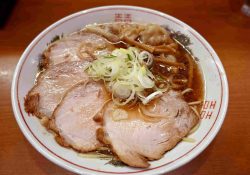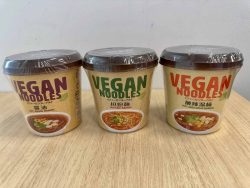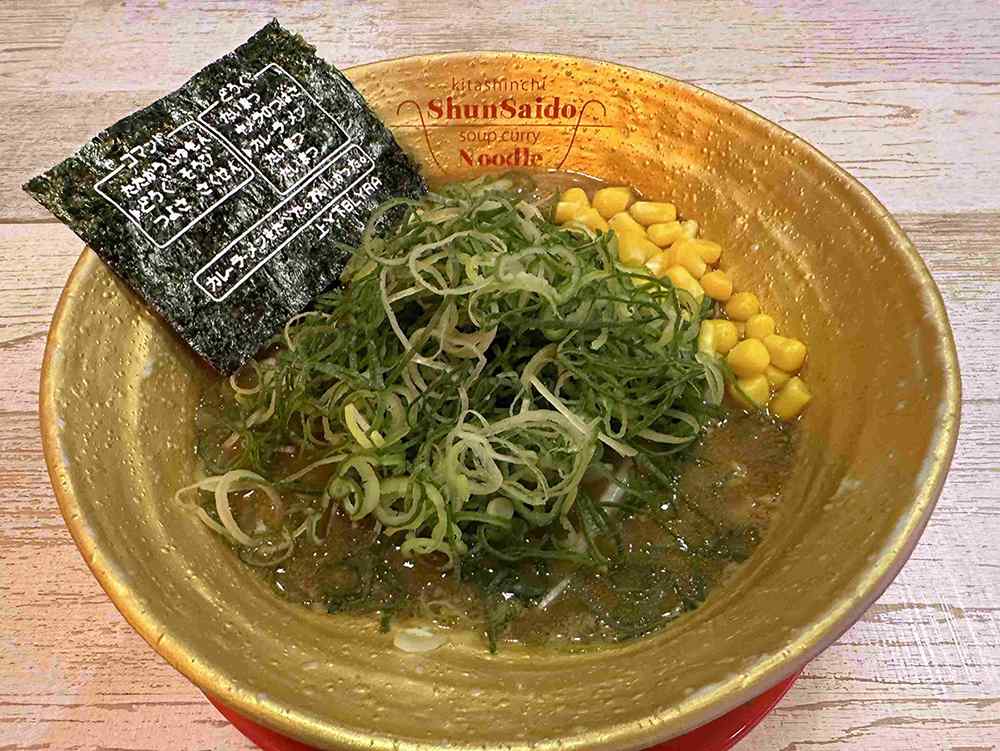
Pork curry ramen, the most popular dish at Shunsaido (¥900)
19:47 JST, January 26, 2024
“The curtain of night falls, the city lights up … ” It was a night that made me feel like singing a Showa song like “Otoko to Onna no Hashigo-zake,” or “a man and a woman going barhopping,” performed by Tetsuya Takeda and Yoshimi Ashikawa.
Kitashinchi in the city of Osaka is a high-class entertainment district with many clubs and bars. The night lights here are dazzling. Somewhere in this neighborhood, on one of its street corners, I was supposed to find curry ramen shop Shunsaido, which is often packed with customers getting their last taste of nightlife before they head home. The late-night ramen eatery, which serves its noodles from 6 p.m. to 3 or 5 a.m., also started opening for lunch this month. I pulled up my coat collar and walked into the district, called simply “Kita” by locals.
I looked for the shop using the map app on my phone, but I passed right by it. There was no sign on the main street. Upon closer inspection, I discovered a long, narrow passageway that led through a building and to its rear. At the end of the passage, I at last found Shunsaido, its only signage a yellow lantern with the word “ramen” on it.
-
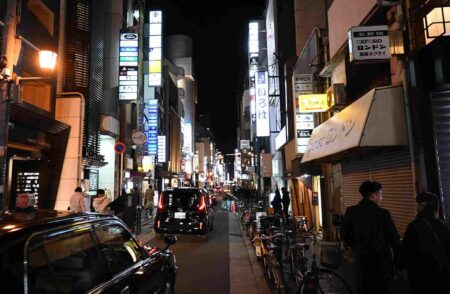
The night is lit up by signs in Kitashinchi.
-
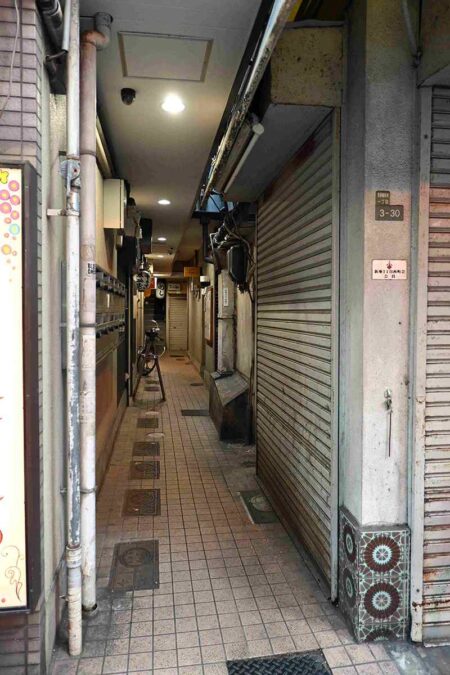
The shop is at the very end of this long, narrow passage.
-
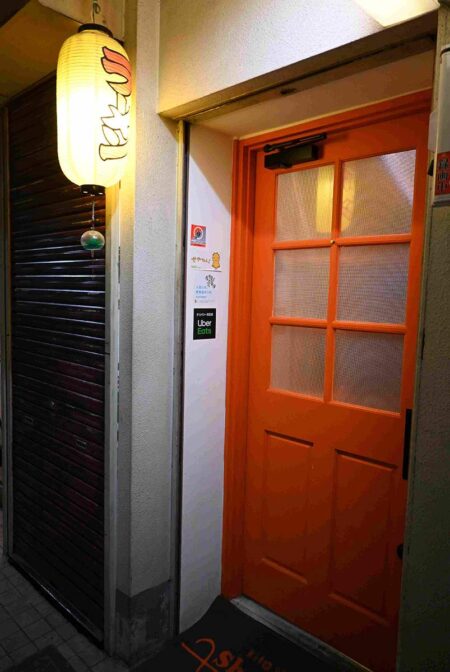
The entrance to Shunsaido
On entering the restaurant, Masaya and Yui Tanimoto, the proprietors, greeted me with smiles. I placed an order for their most popular dish, the pork curry ramen (¥900). 38-year-old Masaya began cooking in the kitchen behind the counter. “I make the curry ramen broth here,” Masaya said, showing me a large cylindrical pot in the back of the kitchen. The curry broth was bubbling gently over the fire, and the pleasant aroma of spices wafted through the air. The broth is not served directly from the pot, but is first set aside to cool and rest, before it is reheated in a smaller pot. Slices of pork shoulder from the refrigerator are also added and simmered in the broth. “This is Mochibuta pork from Miyazaki Prefecture, raised pathogen-free,” says Masaya. When the ramen was ready, it came out in a bowl as golden as the curry itself.
-
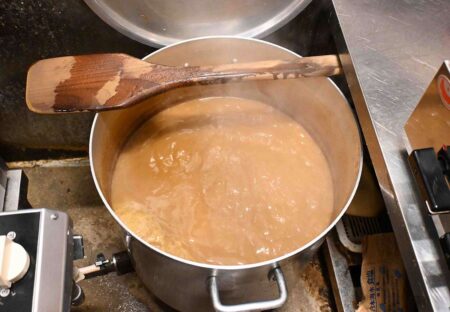
Curry broth simmering in a large pot
-
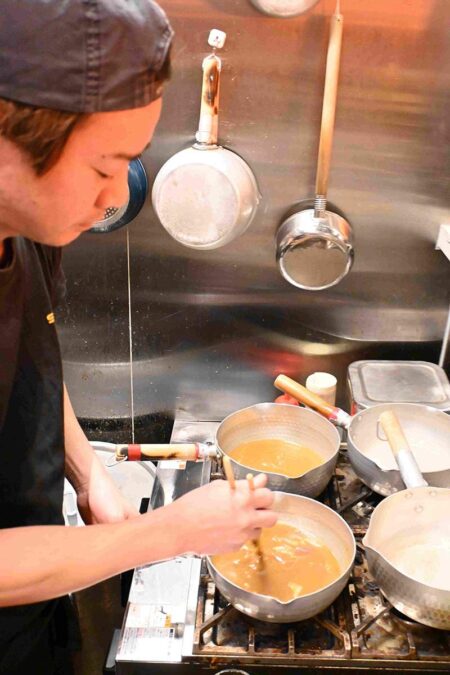
Masaya Tanimoto heats curry broth in a pot.
-

The noodles are ready.
-
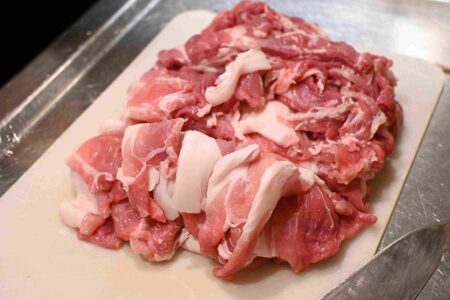
Pork shoulder meat from Miyazaki
I started with the broth, which filled my mouth with delectable curry flavor. It was, however, unlike your typical curry. The flavor was light, and the spices were not intense. It went down easy. The noodles, which Masaya described as “good for curry,” are egg noodles made with Japan-grown wheat, and they are shorter than regular noodles. And indeed, these noodles go well with curry broth. The shorter noodles do not splash the broth when slurped, keeping your shirt or tie nice and clean. The light broth will not sit heavy in your stomach the next day either. But as I kept eating, the spices slowly took effect and warmed me up.
This was due to the broth, which takes much time and effort to prepare. “The base of the broth is made from seven kinds of vegetables. These are Chinese cabbage, onions, carrots, pumpkin, sweet potato, ginger and garlic,” says Masaya. The name Shunsaido means, in Japanese, “a place that brings color to the seasons.” True to its name, Masaya uses a lot of vegetables, and the most prominent vegetable changes with the season: Chinese cabbage in winter, onions in spring, pumpkins in summer, and sweet potatoes in fall.
He also uses 16 spices in his curry, including turmeric, cumin, coriander, cardamom and cinnamon. The curry is prepared daily in the shop’s kitchen.
-
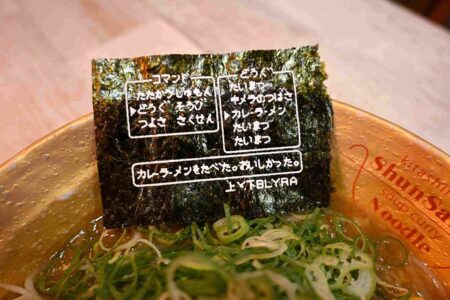
The design on the seaweed was inspired by the Dragon Quest games.
-
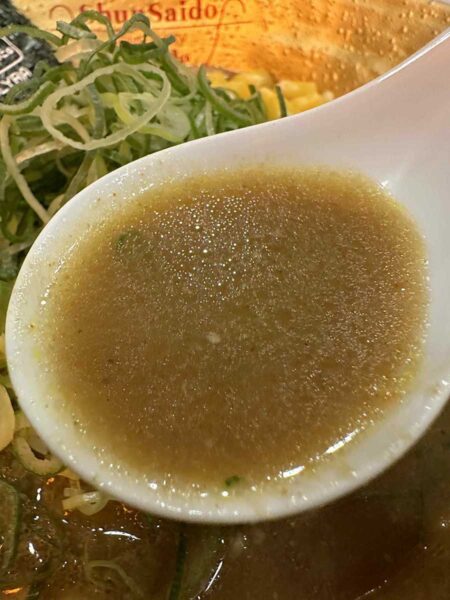
Curry broth that is light and not too spicy
-
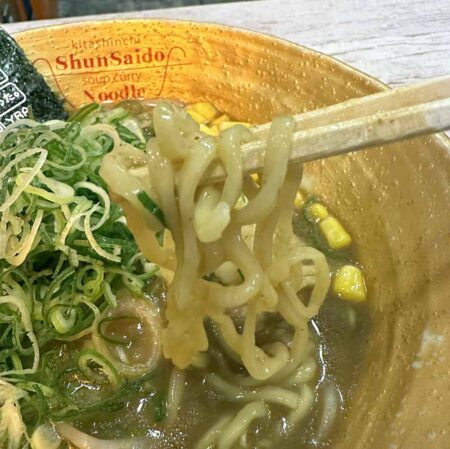
Egg noodles that go well with soup
-

“The noodles are shorter than normal ones,” says Masaya.
The most eye-catching topping is the nori seaweed on which appear words such as “command” and “items.” This is a reference to the video game Dragon Quest. “People who like video games will recognize it right away,” says Yui, 30. There are so many green onions because they no doubt make customers happy, but they must also help ease the guilt of eating ramen at midnight after drinking. “My secret ingredient is white miso paste,” Masaya says. He smiles and adds, “But now that I’ve told you, it is not a secret anymore.” The addition of corn was inspired by miso ramen from Hokkaido.
-

Plum curry tsukemen, or dipping noodles, that feature the exquisite aroma and sour taste of plums (¥1,000)
-
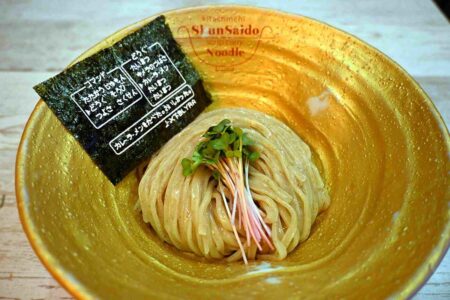
The dipping noodles, made from whole-wheat flour, are soft and delicious.
-
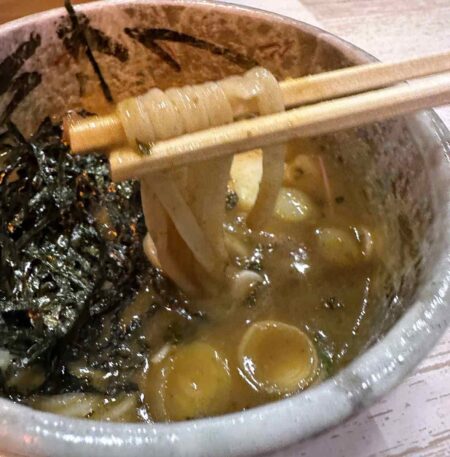
The soup for tsukemen
“Since you came all the way from Tokyo, please try our special tsukemen [dipping noodles],” said Masaya, offering me a bowl of plum curry tsukemen (¥1,000), a popular dish that uses pickled Kishu Nanko plums in its dipping soup. I dipped the noodles in the soup, which is a combination of curry and seafood broths, and as I began to eat, the indescribable aroma and sourness of plums filled my senses. This is another must-try dish.
Two classics in one bowl
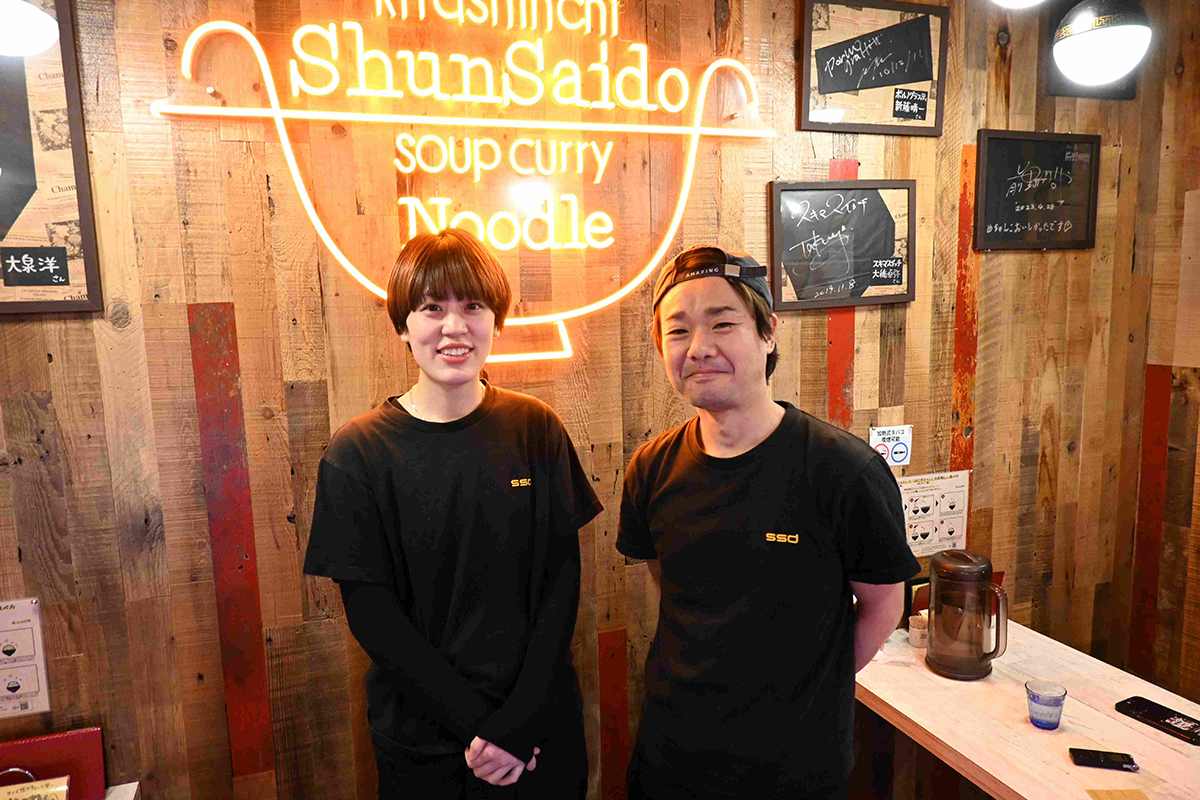
Masaya and Yui Tanimoto run the shop together as husband and wife. Behind them is a custom-made neon sign.
Masaya is from Tanabe, Wakayama Prefecture, and his family is an ume (plum) farmer. This is why he uses Kishu Nanko plums in his ramen. Masaya came to Osaka for college and later opened a bar in Kitashinchi in his 20s. He still runs the bar, and 10 years ago he opened Shunsaido. In fact the idea for a ramen shop came out of his bar business, at a time when turmeric was being advertised as a way to prevent or cure hangovers, and a series of drinks and pills based on the spice were being launched. Turmeric is an essential ingredient in curry, and many customers in the district look for a nice broth to slurp down once they’ve finished drinking. Curry udon is also very popular in Osaka, and there are many restaurants that specialize in curry. All this led Masaya to start his shop specializing in curry ramen. He had always loved ramen and even trained at a ramen shop during his bar days.
-

The counter and two table seats in the shop
-

Counter seats
-

Shunsaido’s menu. You can choose how spicy you want your noodles to be.
-
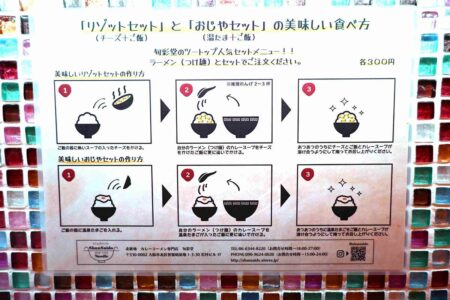
You can also make a delicious risotto using the curry broth.
-
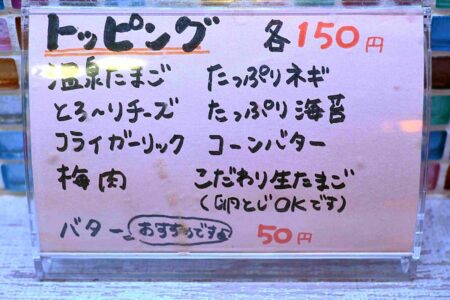
Additional toppings are available for ¥150 each.
-

A golden curry sauce boat
This is how Shunsaido was born, combining ramen and curry, two of the most popular dishes among Japanese people. However, when the restaurant first opened, many people asked, “Don’t you have any more ordinary ramen?” The curry was too strong. After much trial and error, tinkering to find the right balance between curry and ramen flavors, he finally arrived at his current recipe five years ago.
Yui started working part-time at Shunsaido when she was a college student and married Masaya seven years ago. “Lunch time here starts at midnight, and we get full up then. We live day and night in reverse,” she said, smiling. But unlike at normal lunch hours, most customers come after a drink. Many are regular customers and some of them have even started visiting with their children at earlier hours. This got Masaya thinking. “It would be nice to open during the day so young people and families could also come here to eat,” he told himself. And so now he’s serving lunch, too.
“I want to establish the genre of curry ramen,” says Masaya. To which Yui added, “I want people to try the best of both worlds, curry and ramen.” This year is the 10th anniversary of Shunsaido, and the pair plan to open another shop.
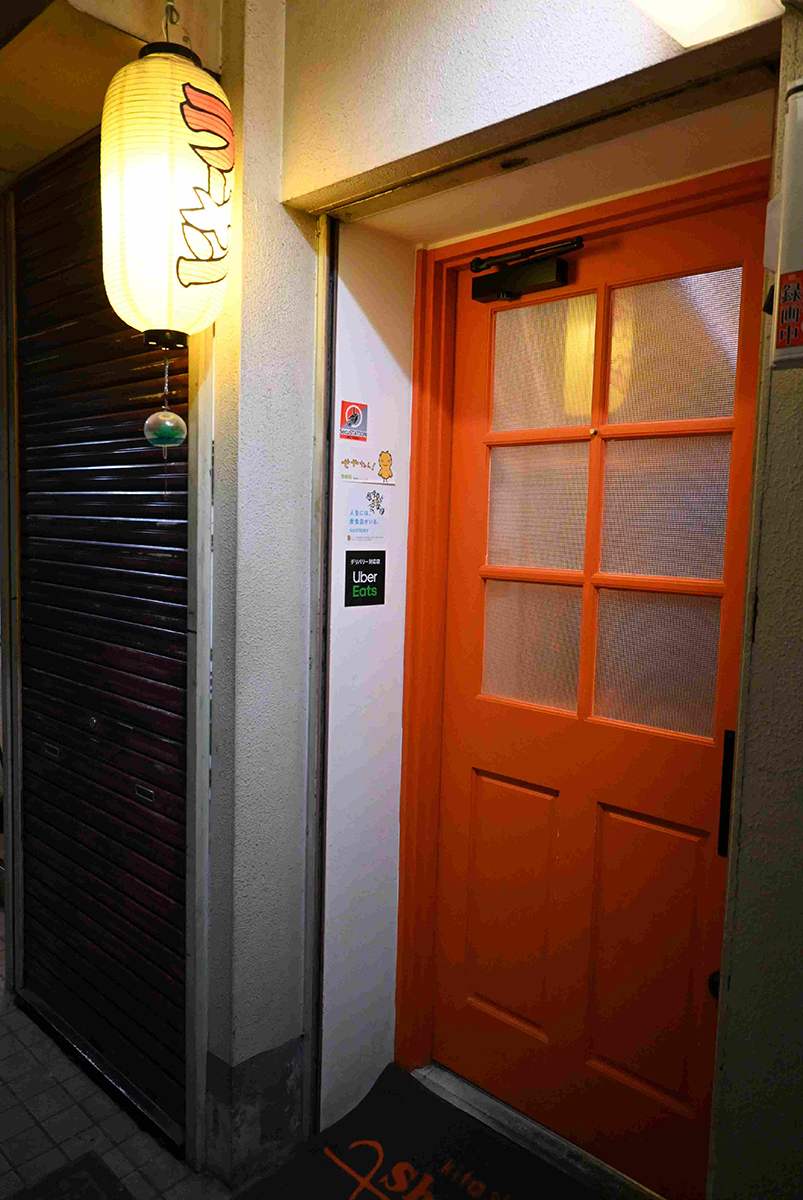
Shunsaido
1-3-30 Sonezaki-shinchi, Kita Ward, Osaka. Lunch: 11:30 a.m. to 2:30 p.m.; dinner: 6 p.m. to 3 a.m. (on Fridays and days before holiday, open until 5 a.m. the following morning; Saturdays, until 2 a.m.). For more information, visit the shop’s official Instagram (@shunsaido).
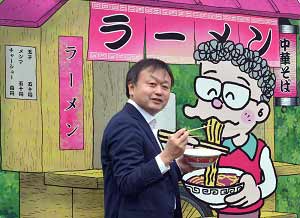
Futoshi Mori, Japan News Senior Writer
Food is a passion. It’s a serious battle for both the cook and the diner. There are many ramen restaurants in Japan that have a tremendous passion for ramen and I’d like to introduce to you some of these passionate establishments, making the best of my experience of enjoying cuisine from both Japan and around the world.
Japanese version
【ラーメンは芸術だ!】大阪・北新地のカレーラーメン「旬彩堂」、ネオン街で光る「勝負の一杯」

"JN Specialities" POPULAR ARTICLE
-

The Japan News / Weekly Edition (12/12-12/18)
-

Noodle Dining Shunsai / Rich Oyster Ramen to Savor at Odasaga; Experienced 68-year-old Owner Creates Numerous Ramen Varieties
-

The Japan News / Weekly Edition (12/5-12/11)
-

People Keep Loved Ones’ Ashes Close in Special Jewelry, Small Urns as Unique Way to Memorialize Them
-

The Japan News / Weekly Edition (12/19-12/25)
JN ACCESS RANKING
-

Keidanren Chairman Yoshinobu Tsutsui Visits Kashiwazaki-Kariwa Nuclear Power Plant; Inspects New Emergency Safety System
-

Tokyo Economic Security Forum to Hold Inaugural Meeting Amid Tense Global Environment
-

Imports of Rare Earths from China Facing Delays, May Be Caused by Deterioration of Japan-China Relations
-

University of Tokyo Professor Discusses Japanese Economic Security in Interview Ahead of Forum
-

Japan Pulls out of Vietnam Nuclear Project, Complicating Hanoi’s Power Plans



